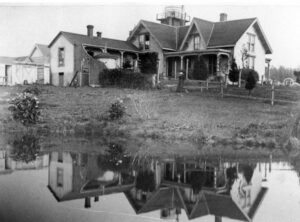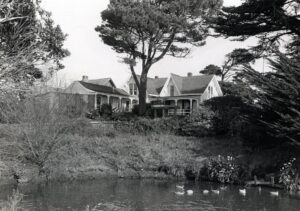One of the most attractive spots in town at present is the little lake on the grounds of Mr. W. H. Kelly’s residence on Main Street. It is full to overflowing of clear water, while around its banks the calla lilies are blooming in all their beauty. A miniature sailboat gracefully skimming over the water adds to the picturesque scene. –Mendocino Beacon, 16 January 1886
This short description, penned 134 year ago, reminds us that late winter and spring is the season of the Calla Lily (Zantedeschia aethiopica), those always elegant yet robust plants growing in coastal roadside ditches, accenting moist garden beds, and lighting up shady glens.
In the late 1800s, horticultural fashion emphasized the bold and exotic for both indoor and outdoor decorations – think philodendrons, caladiums and other large leafed plants. While we don’t know exactly when they arrived in Mendocino, it’s possible that someone received a pot of Callas as a treasured gift or a plant was purchased on a trip to San Francisco. Once folks discovered how easy they were to grow here on the coast, their tuberous roots would have been shared by neighbors and friends.


The Kelley House archives contain photos from that time right up to today showing the Kelley Pond decorated with lush clumps of these tuberous South African perennials. Native to the Cape area, they have several names in that region, including wit varkoor (Afrikaans); intebe (Xhosa) and ihlukwe (Zulu). In the US they are often called “arum lily”, or “Easter lily” since their bloom coincides with that spring event. In fact, Callas are neither an arum nor a lily, but are in a genus all to themselves.
Whatever their source, they have found our coastal climate so like their native African one, that they volunteer here with abandon, and can also be spread by birds who relish their seeds.
My favorite locality for viewing them is not in gardens, but in the river of white they make each year in the Mendocino Headlands Park. Here, behind the Ford House Visitor Center on Main Street, Calla Lilies have filled linear depressions where the old lumber mill tramway once ran. I can’t help but think the nearby Kelley pond is the mother for this magical and unexpected flower bed.
Looking for some clue as to their beginning here within the fascinating pages of old Beacon newspapers, I found that they have been celebrated in newsprint every single year from 1879 through at least the 1970s. Along the coast, there were reports of Callas gracing the alters of Protestant and Catholic Easter services, adorning church and garden weddings, and making beautiful the halls and club rooms where Mendo people of all types gathered for play and community.
While here Callas grow wild – something newcomers and visitors find astonishing – most peoples’ lust for them elsewhere must be satisfied at florist shops. These were supplied by professional plant growers like Carl Purdy of Ukiah, well known to people here in the early 1900s for his gathering trips to the coast. He also contracted with J. S. Cotton who planted at Cleone 75,000 Calla Lily bulbs, according to a 1911 Beacon news piece.
But as the water table dropped in the latter part of the 1900s, the moisture-loving Callas growing around the Kelley pond did not fare well. Eventually, they were dug up and given away as various renovation efforts were undertaken during those years.
The most recent re-construction, though, seems to have finally made the difference and the pond is looking quite restored. Our past few winter rains have been relatively generous, and water can be found in the pond year-round.
The odd bulges that appeared immediately in winter after the construction due to trapped air and water below the rubber liner, and which resembled the backs of submerged sea creatures, have not shown themselves this last season.
The water’s edge, where the liner was sometimes visible, looks more natural with each passing year, filling in with grassy plants and – Calla Lilies! A sweet return.
Other welcome things are happening around this beloved landscape feature. Pastor Matt Davis’ Holy Goats are scheduled to start munching away at the weeds around the pond soon. Long-time supporter and hardworking past board member Bill Lemos, with the help of Chris Brians, have repaired an aerator supply line just this past week. And volunteer Bob Kerstein hopes to replace a run of the pond fence in the near future.
The Kelley House staff and board would like to again express our gratitude for the continued support of these men, and all of the dozens of other community members that help preserve this lovely old house, its gardens, and the “little lake” on Main Street.
If you would like to contribute your time or offer financial support to the preservation of one of Mendocino’s oldest homesteads, please give us a call at 707-937-5791, or write to us at curator@kelleyhousemuseum.org.